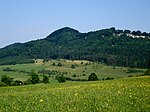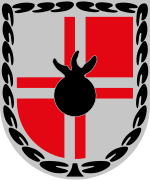Weichenwang
Mountains and hills of the Swabian JuraZollernalbkreis

Weichenwang is a 988.5 m-high (3,243 ft) mountain in the Swabian Jura in the town of Meßstetten, Zollernalbkreis in Baden-Württemberg, Germany. Since 1963 a radome of the Bundeswehr has been there, but its use as a military site is considerably older. Before the radome was built there had been a radio listening-post there.
Excerpt from the Wikipedia article Weichenwang (License: CC BY-SA 3.0, Authors, Images).Weichenwang
Zum Riedhof, Gemeindeverwaltungsverband Meßstetten
Geographical coordinates (GPS) Address Nearby Places Show on map
Geographical coordinates (GPS)
| Latitude | Longitude |
|---|---|
| N 48.183333333333 ° | E 8.95 ° |
Address
Zum Riedhof 18
72469 Gemeindeverwaltungsverband Meßstetten (Gemarkung Meßstetten)
Baden-Württemberg, Germany
Open on Google Maps






